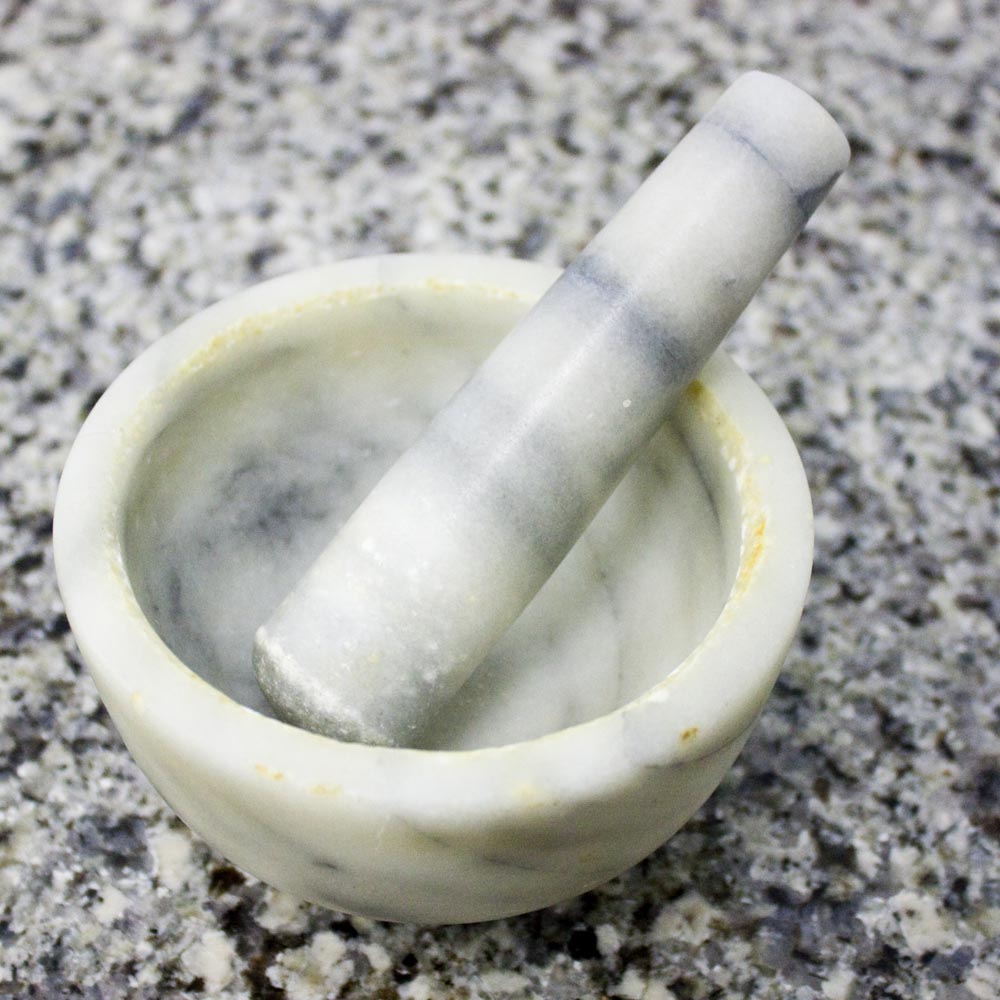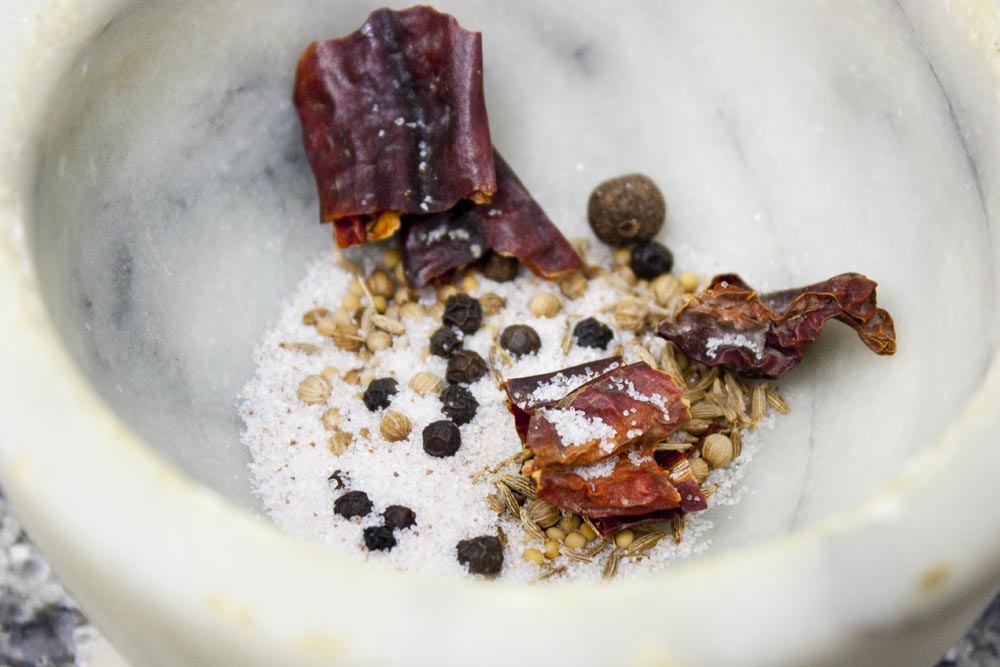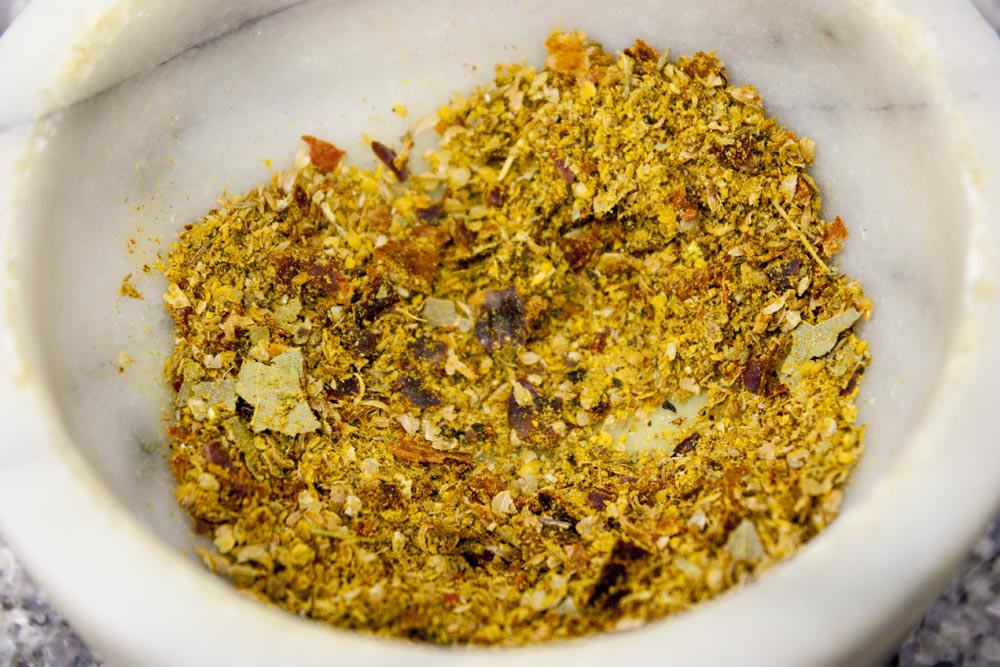About mortars and pestles
Mortars and pestles are simply a hollowed or bowl-shaped object(mortar) and a stick(pestle) made of a hard material and used to crush ingredients into a powder or paste. The usual material for mortars and pestles is stone, with marble, granite and basalt the most frequently used. These three types of stone give the necessary qualities for good grinding: they are harder than anything you would want to grind up for food and they have a little “tooth” or roughness to make grinding easier and faster.
A mortar and pestle made of obsidian(volcanic glass) would be too smooth and ingredients could only be crushed rather than ground finely. Most wood is much softer than stone and not only wears out sooner but also contributes a lot of wood fiber to the ingredients being ground. Both obsidian and wood make the process more difficult and slower.
My favorite materials for mortar and pestles are marble and granite. The most important trait of these two materials is that they are usually light-colored. This allows a cook to easily see the state of whatever is being ground and better tell when a mortar and pestle is properly clean. Both marble and granite are also hard enough to wear very slowly without contributing much material to the ingredients.
A brief history of food grinding
Mortars and pestles were the original grain mills, food processors and blenders. They have been used for hundreds of thousands of years to grind grains like dried corn, millet and wheat into flour suitable for baking and other uses. After the invention of water powered machinery, grind-stones in centralized mills replaced many household mortars and pestles for this purpose. They really fell out of favor after electricity became common and electric appliances took their place in most commercial and home kitchens. Today they are seen by many cooks as a relic of the past.
Why I use a mortar and pestle
I like to use whole spices. Whole spices are usually fresher when purchased and have a much longer shelf life than ready-to-use spices that are already in powdered form. Using whole spices also ensures a clean product without unexpected added ingredients; you know exactly what you are putting into any recipe. There is also nothing else like the aroma and flavor of fresh-ground spices in the kitchen – bread baking in the oven probably comes closest. And like fruit and vegetable juices, spices start to oxidize and lose flavor and nutritional potency as soon as they are ground. I like to maintain the highest possible levels of nutrients and flavor is my food.
A mortar and pestle is superior to a spice grinder. Spice grinders, even pepper mills, chop the spices into ever finer pieces with blades. Mortars and pestles both crush and grind the spices, releasing more aromatics. The process is also more easily controlled when using a mortar and pestle because it happens more slowly and right before your eyes. The ingredients can be left fairly course to give distinct flavor bursts in the finished recipe or they can be finely powdered for very even and complete flavor dispersal.
How to use a mortar and pestle
It seems pretty straight forward but there are a few tricks that make using a mortar and pestle easier and faster.
With whole, hard spices such as allspice, peppercorns, nutmeg and other seeds, start by using the pestle to crush the seeds by pressing down and twisting at the same time. When all of the whole spices have been broken up, finish the grinding process by sliding the pestle around the the mortar bowl until the spices are at fine as necessary for the particular recipe. This is where the “tooth” or slight roughness of the mortar, mentioned above, comes into play. This “tooth” catches the small pieces of spice rather than just letting it slide around.
When grinding fresh herbs, usually leaves, just the sliding, swirling motion is often all that is needed. Because of the moisture in fresh herbs, the result is more of a paste than a powder. This makes a great rub for meats, fish and vegetables or as an ingredient for sauces and drinks. As with whole hard spices and seeds, the aroma produced during the grinding process enhances the kitchen experience.
Other uses for a mortar and pestle
Mortars and pestles make a good alternative to blenders and food processors when making raw or cooked sauces. As with dry spices and fresh herbs, they give more control over the process by slowing things down. Crushing more than cutting, mortars and pestles release more flavor and aroma than their electric equivalents, too.
Think of a mortar and pestle whenever you need to grind or puree ingredients in the kitchen. For those making raw recipes, this versatile kitchen tool avoids the heat often produced by electric blenders and food processors. This can also be a factor when making ingredients for chilled recipes or drinks.
Why a mortar and pestle is still relevant
This tool still has a place in the modern kitchen for several reasons. Electric food processors and blenders to not replicate what a mortar and pestle does, even though the final result can appear quite similar. For small jobs such as grinding a few spices or herbs for a single meal, a mortar and pestle is faster and easier because there is no set-up and the cleaning is simpler. There is a certain level of satisfaction and connection with the food achieved by using a mortar and pestle that is simply not there when the job is done with an electric kitchen appliance. And sometimes, the power goes out when we are hungry and those nifty electric appliances cannot be used.




